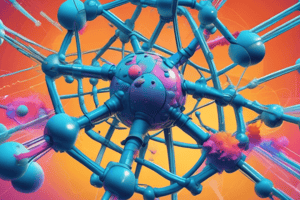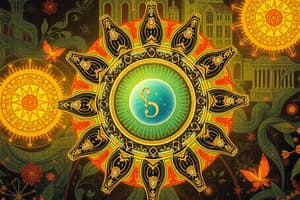Podcast
Questions and Answers
What is an alpha particle composed of?
What is an alpha particle composed of?
- One proton and one neutron
- One proton and one electron
- Two protons and two neutrons (correct)
- Two protons and one neutron
Which of the following describes a beta particle?
Which of the following describes a beta particle?
- It is equivalent to a helium nucleus
- It consists of two protons
- It consists of one electron (correct)
- It is a positively charged particle
How is the atomic number of an element denoted in its symbol?
How is the atomic number of an element denoted in its symbol?
- At the lower right
- At the upper right
- At the upper left
- At the lower left (correct)
What does the mass number of an atom represent?
What does the mass number of an atom represent?
What is a daughter product in the context of radioactive decay?
What is a daughter product in the context of radioactive decay?
Which form of electromagnetic radiation has the highest energy?
Which form of electromagnetic radiation has the highest energy?
What characterizes an isotope of an element?
What characterizes an isotope of an element?
Which of the following statements about radioactive atoms is true?
Which of the following statements about radioactive atoms is true?
What happens to the element during alpha decay?
What happens to the element during alpha decay?
Which of the following describes gamma decay?
Which of the following describes gamma decay?
What is a major characteristic of a half-life in radioactive decay?
What is a major characteristic of a half-life in radioactive decay?
During beta decay, what occurs with one neutron in the nucleus?
During beta decay, what occurs with one neutron in the nucleus?
Which process involves the splitting of a nucleus into two lower mass nuclei?
Which process involves the splitting of a nucleus into two lower mass nuclei?
What defines a radioactive isotope?
What defines a radioactive isotope?
After a certain number of decays, what can happen to a radioactive nucleus?
After a certain number of decays, what can happen to a radioactive nucleus?
Which phenomenon is characterized by the combination of two nuclei into one?
Which phenomenon is characterized by the combination of two nuclei into one?
Flashcards
Alpha Particle
Alpha Particle
A positively charged particle emitted from a radioactive atom's nucleus, consisting of 2 protons and 2 neutrons.
Atomic Number (Z)
Atomic Number (Z)
The number of protons in an atom's nucleus. Used to distinguish elements.
Beta Particle
Beta Particle
A negatively charged particle (electron) emitted from a radioactive atom's nucleus.
Daughter Product
Daughter Product
Signup and view all the flashcards
Gamma Ray
Gamma Ray
Signup and view all the flashcards
Isotope
Isotope
Signup and view all the flashcards
Mass Number (A)
Mass Number (A)
Signup and view all the flashcards
Nuclear Decay
Nuclear Decay
Signup and view all the flashcards
Positron
Positron
Signup and view all the flashcards
Radioactive
Radioactive
Signup and view all the flashcards
Subatomic Particle
Subatomic Particle
Signup and view all the flashcards
Radioactive Decay
Radioactive Decay
Signup and view all the flashcards
Alpha Decay
Alpha Decay
Signup and view all the flashcards
Beta Decay
Beta Decay
Signup and view all the flashcards
Gamma Decay
Gamma Decay
Signup and view all the flashcards
Transmutation
Transmutation
Signup and view all the flashcards
Half-life
Half-life
Signup and view all the flashcards
Fission
Fission
Signup and view all the flashcards
Fusion
Fusion
Signup and view all the flashcards
Study Notes
Alpha Particles
- Positively charged particles emitted from a radioactive atom's nucleus.
- Composed of two protons and two neutrons, equivalent to a helium nucleus.
Atomic Number
- Number of protons within an atom's nucleus.
- Distinguishes elements.
- Represented by the symbol Z, shown at the lower left of an element symbol.
Beta Particles
- Negatively charged particles emitted from a radioactive atom's nucleus.
- Consists of a single electron.
Daughter Product
- The atom resulting from radioactive decay.
Gamma Rays
- Highest-energy form of electromagnetic radiation.
- Wavelengths less than 10 picometers.
- Often emitted during nuclear decay.
Isotopes
- Different forms of the same element.
- Same number of protons, different numbers of neutrons.
- Mostly radioactive, with only one or two stable isotopes per element.
Mass Number
- Total number of protons and neutrons in an atom's nucleus.
- Represented by the symbol A, shown at the upper left of an element symbol.
- Example: Helium's mass number is 4 (2 protons + 2 neutrons).
Nuclear Decay
- Spontaneous release of particles and/or energy by a radioactive atom.
- Types include alpha, beta, and gamma decay.
- Alpha decay: Emission of an alpha particle (2 protons, 2 neutrons).
- Beta decay: Emission of a beta particle (1 electron). A neutron transforms into a proton in this process.
- Gamma decay: Emission of gamma rays (high energy electromagnetic waves). No change in the nucleus's composition.
Positrons
- Positively charged antimatter counterpart of an electron.
- Annihilation occurs when a positron meets an electron, releasing gamma rays.
Radioactive
- Capable of releasing radiation.
- Radioactive atoms have nuclei that spontaneously decay, emitting particles and/or energy.
Subatomic Particles
- Units of matter smaller than atoms.
- Include protons, neutrons, electrons.
- Protons and neutrons are composed of quarks and other smaller particles.
Nuclear Chemistry
- Two main topics: radioactive decay and fission/fusion.
Radioactive Decay (details)
- Certain isotopes (like Uranium-235) have unstable nuclei.
- These radioactive isotopes decay to become more stable, releasing energy.
- Multiple decays can occur in a sequence.
- Transmutation can occur, changing the element.
- Alpha decay changes the element by losing protons and neutrons. (e.g., Bismuth-210 to Thallium-206)
- Beta decay changes the element by converting a neutron to a proton. (Releases an electron; not from electron cloud).
- Gamma decay doesn't change the element, just releases energy.
Half-Lives
- Time for half of a radioactive sample to decay is the half-life.
- Half-life varies significantly based on the element.
- Decay rate follows exponential decay.
Fission
- Splitting an atom's nucleus into two nuclei with lower mass.
Fusion
- Combining two nuclei into one.
Studying That Suits You
Use AI to generate personalized quizzes and flashcards to suit your learning preferences.
Description
Test your knowledge on key concepts of radioactivity and atomic structure. This quiz covers alpha and beta particles, isotopes, atomic numbers, and more. Enhance your understanding of fundamental nuclear chemistry topics!





